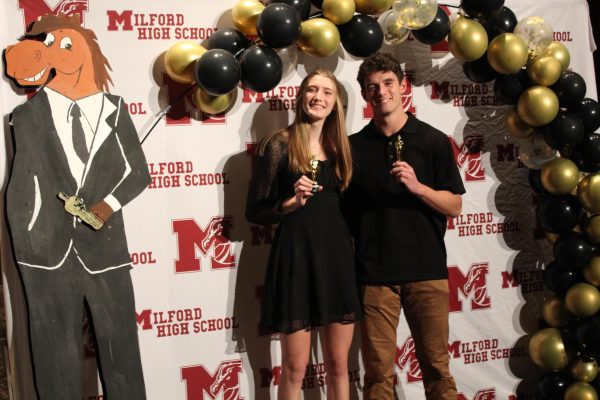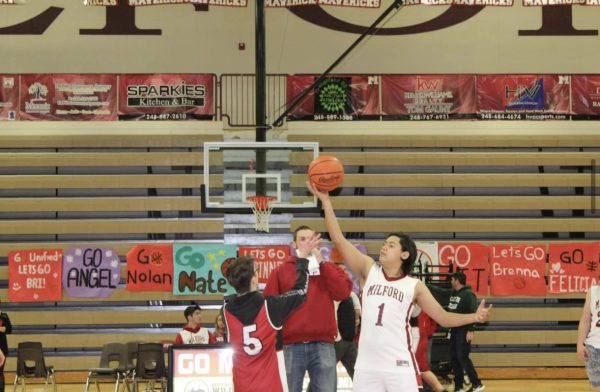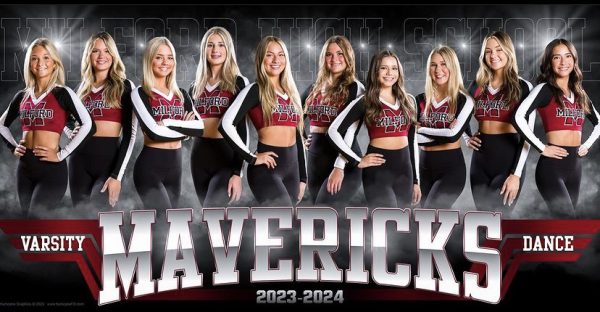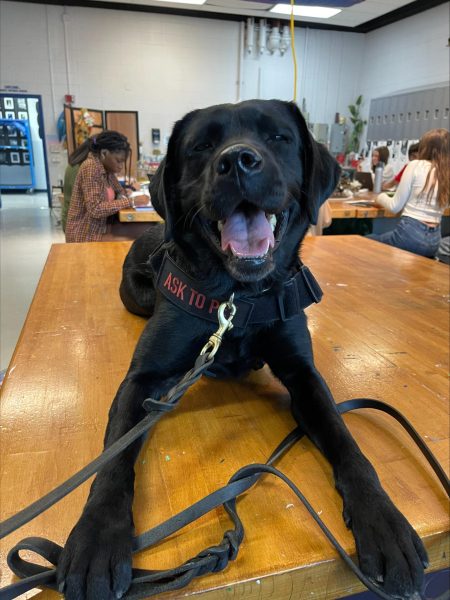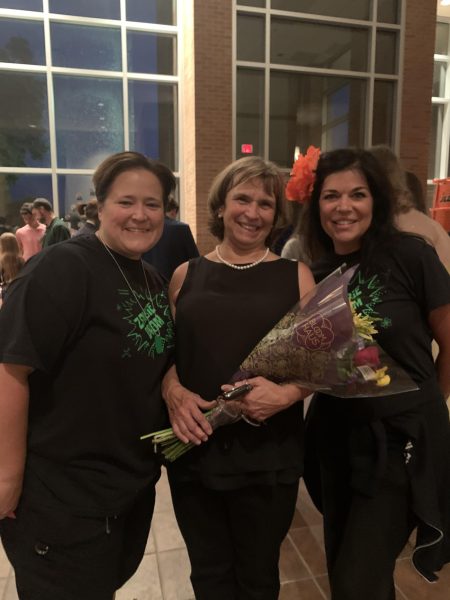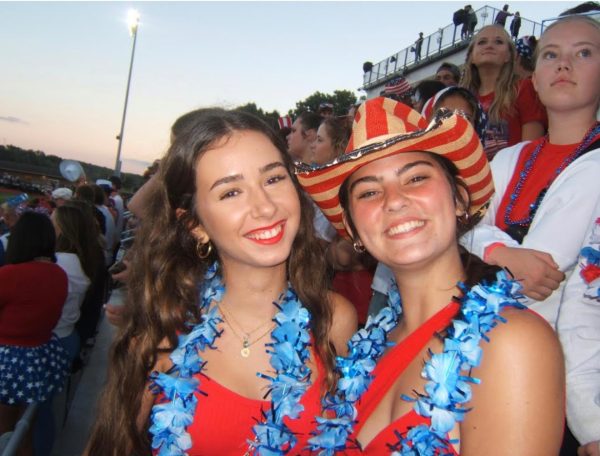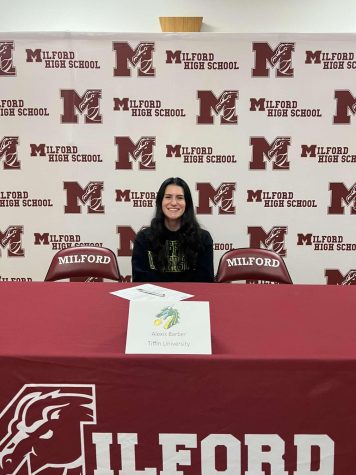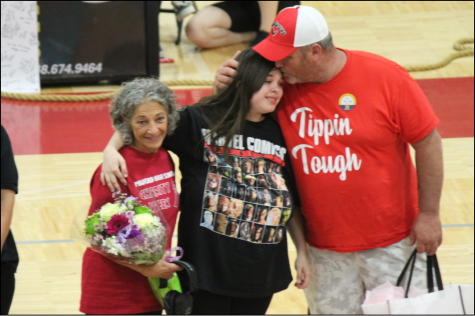Historical Milford: changes in a near 100-year history
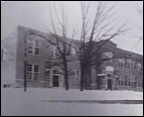
https://www.milfordhistory.org/
The original Milford High School on Hickory Street (Photo courtesy of the Milford Historical Society).
March 24, 2022
Most people know that Milford’s mascot was formerly the Redskins. The Milford Mavericks were born in the 2002-2003 school year, and remain the beloved mascot of MHS. But fewer know that before the Redskins, Milford was known as the Trojans. Over the last century, Milford High School has changed just as much as its mascots – some well-known and others not so much.
The first building in Milford specifically for high school students was built in 1926 and christened the “Milford Rural Agricultural School.” Since then, Milford High School has had a rich history. From the move from Hickory Street to the current Highland location in 1959, to the ups and downs of success in sports and clubs, and several mascot changes, MHS has seen many changes in its long life. The school and community we know and love was very different nearly a century ago.
For example, sports and clubs at Milford have seen drastic developments over the years. There are more than 20 sports teams offered at Milford, and even more clubs and extracurriculars. But in its earlier days, MHS had only a few sports teams: football, basketball, softball, and track. These teams functioned much differently than today. There wasn’t arranged transportation for teams, and they were much smaller. Throughout the years, Milford added more sports (hockey, swim & dive, equestrian, etc.) following a boom of teams created in the 1960’s-1980’s.
Milford has grown academically as well. In MHS’s early years, there were classes such as shorthand, which was a form of writing in simplified letters and was essential for secretaries and quick note-takers; Latin; and typing – on manual typewriters. The variation of classes offered has grown from just a few required classes and similarly few electives at the beginning to boasting more than sixty electives and several options for math, science, and English requirements.
Thelma Armstrong (Burley), class of 1941, compares class technology current and past: “I received an award for reaching 70 words per minute in shorthand… you had to be perfect [when writing shorthand or using a typewriter] – no mistakes. You couldn’t delete things like today.” As part of a business class Armstrong took, she was a teacher’s aide to Theresa Kurtz – whom Kurtz elementary was later named for. Armstrong recently celebrated her 98th birthday and still lives in Highland with her family – four generations of Milford students.
Mark Gibson’s (class of 1977) favorite class was Studio Arts, in which the students were able to leave campus for several hours at a time to create art in different places (such as Kensington Metropark) in the community. “It was really cool,” he said. “We would go to the park and just spend the whole day sketching trees, the landscape, whatever.” Milford no longer offers this class, but still has a varied visual arts department with classes such as Pottery, Drawing and Painting, and Photography.
When English teacher Emily Mienkwic (class of 2012) attended Milford, French was offered as a language class. Mienkwic did not take French, but her favorite class was Great Works. She says her favorite thing about MHS was “a tie between the Bosco Sticks I had for lunch every day and any of my ELA classes.” While the Bosco sticks are a consistent lunchtime staple at Milford, academics have developed into the classes we all take today.
The physical building has seen perhaps the most change. The original high school building on Hickory Street grew. A new building was constructed in the 1950’s, moving from the original Milford location to the current Highland address. Even then, the building has had several additions. Pools & Fitness was added, along with the Fieldhouse, and the CPA replaced the Little Theater for major performances.
Gibson remarked, “The new CPA is much bigger, better for shows… That wing is new since I was there; it’s great.” A few parking lots and the changed locations of the main office and the media center (formerly located in Mr. Riggs’ room – the current media center was added in the 1990s) are among other notable modifications to MHS.
The student body has evolved as well. On the walls of the main hallway are the graduated classes of Milford. The first photo has a few dozen students, while the class of 2022 has almost 400. Armstrong’s graduating class had 63 members (5 are still living), and only about 270 total students attended Milford at the time. She says that the smaller class size brought the students closer, and that there was little divide between upperclassmen and underclassmen.
In recent years Milford has experienced a decline in enrollment, and currently has around 1,300 students. This is a sharp change from recent decades, when Milford had graduating classes of more than 400. Much of the decline is attributed to the pandemic, and it has led to budget cuts and closed schools.
In its long life, MHS has evolved and grown into the school it is today. To predict what changes there will be in ten, twenty, fifty years from now is impossible, but to think of the future is exciting. What new classes, technology, or teaching methods will future generations have? Will Milford be as different in another hundred years as it is now from 1926?
